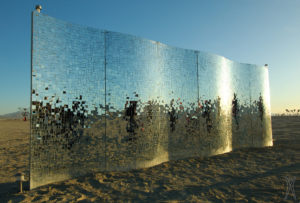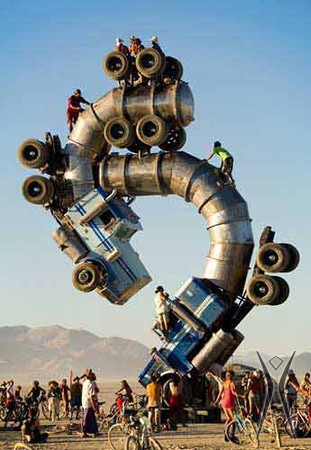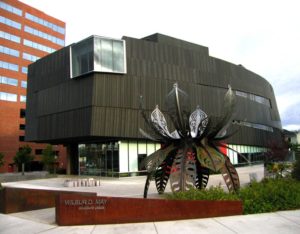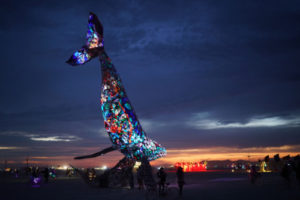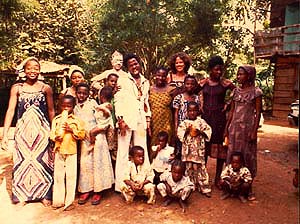By Larry Harvey
I am in love with this green earth; the face of town and country; the unspeakable rural solitudes, and the sweet security of streets. — Charles Lamb
This essay was originally intended to answer a question put to me by Wendy Clupper, a doctoral candidate in the field of performance studies. She wrote, “Can you tell me what performing was like for you the first years on the playa? And what was your role in the 1996 Helco performance — what was it about?” Had she not asked about my personal involvement, I might have answered her with greater brevity. Instead, this caused me to reflect upon a chapter in the unheralded history of Burning Man. What follows is a partial account of our early years and the nature of interactive performance.
 Our first years of performance represent a dialogue between the town and country. Our urban shows are now almost forgotten. In 1994, Pepe Ozan and I founded the first of these shows in San Francisco’s SOMARTS gallery. Our second effort was entitled The Odd, the Strange, the Weird, and the Wholly Other. We installed the Burning Man in an upright position beneath the soaring vault of the former foundry’s 4-story high space. We equipped the inside of the figure’s head with a microphone, a speaker and a video camera. These were connected to a microphone, a monitor and headphones discreetly located in a curtained booth near the base of the statue. A rope and pulley fastened to a ceiling beam allowed participants to clamber into a boson’s chair and be raised high overhead by their friends. This, of course, required that they trust these friends. Suspended immediately adjacent to Burning Man’s large triangular face, participants were urged to talk to this authoritative presence and put questions to it. Those who lurked inside the curtained booth below would then supply the answers. Our sound system automatically transformed their voices into a deep basso profundo.
Our first years of performance represent a dialogue between the town and country. Our urban shows are now almost forgotten. In 1994, Pepe Ozan and I founded the first of these shows in San Francisco’s SOMARTS gallery. Our second effort was entitled The Odd, the Strange, the Weird, and the Wholly Other. We installed the Burning Man in an upright position beneath the soaring vault of the former foundry’s 4-story high space. We equipped the inside of the figure’s head with a microphone, a speaker and a video camera. These were connected to a microphone, a monitor and headphones discreetly located in a curtained booth near the base of the statue. A rope and pulley fastened to a ceiling beam allowed participants to clamber into a boson’s chair and be raised high overhead by their friends. This, of course, required that they trust these friends. Suspended immediately adjacent to Burning Man’s large triangular face, participants were urged to talk to this authoritative presence and put questions to it. Those who lurked inside the curtained booth below would then supply the answers. Our sound system automatically transformed their voices into a deep basso profundo.
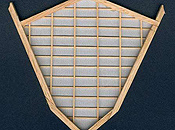 This installation provoked many absurd dialogues — most memorably, an exchange between a participant and Michael Hopkins (popularly known as Flash), my good friend and a veteran of Burning Man’s early days on the beach. “What do I love?” a participant asked the shoji screen face. “Your car! … you … love …your … car”, the Man intoned. Lowered to the floor, she turned to her companions, jumping up and down ecstatically. “I can’t believe what he told me!”, she breathlessly announced. “He told me that I love my car, and I do love my car! I do love my car!” The Man had once again reflected back to a participant what she projected onto it. Over the ensuing years, these urban shows increased in scope. They expanded to fill the entire SOMARTS complex and were eventually used to premiere Burning Man’s annual art theme.
This installation provoked many absurd dialogues — most memorably, an exchange between a participant and Michael Hopkins (popularly known as Flash), my good friend and a veteran of Burning Man’s early days on the beach. “What do I love?” a participant asked the shoji screen face. “Your car! … you … love …your … car”, the Man intoned. Lowered to the floor, she turned to her companions, jumping up and down ecstatically. “I can’t believe what he told me!”, she breathlessly announced. “He told me that I love my car, and I do love my car! I do love my car!” The Man had once again reflected back to a participant what she projected onto it. Over the ensuing years, these urban shows increased in scope. They expanded to fill the entire SOMARTS complex and were eventually used to premiere Burning Man’s annual art theme.
 The idea of an art theme derived from our experience of the desert. The simple act of encounter in an immense open space can be compelling. I remember one of my own first experiences with a large-scale work at our event in 1992. The artist, Vince Koloski, had installed a sprawling geometric pictogram upon the ground, mounting it six inches above the playa’s surface. It was composed of neon tubing in contrasting colors. I still recall my fascination as I walked around it in the dark. With each step, it seemed to reconfigure. It felt as if this object answered to my effort, as if my progress through the space were animating it. It soon became apparent that the Black Rock Desert’s stunning vacancy allowed participants to appropriate artworks as an element of their unique experience.
The idea of an art theme derived from our experience of the desert. The simple act of encounter in an immense open space can be compelling. I remember one of my own first experiences with a large-scale work at our event in 1992. The artist, Vince Koloski, had installed a sprawling geometric pictogram upon the ground, mounting it six inches above the playa’s surface. It was composed of neon tubing in contrasting colors. I still recall my fascination as I walked around it in the dark. With each step, it seemed to reconfigure. It felt as if this object answered to my effort, as if my progress through the space were animating it. It soon became apparent that the Black Rock Desert’s stunning vacancy allowed participants to appropriate artworks as an element of their unique experience.
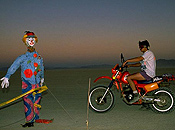 We also began arranging artist’s installations on an axis in space, and this evolved into a very basic interactive strategy. By placing installations in a row and traveling along it, it was possible to evoke drama on a grandiose scale. In 1994, this Avenue of Art, as it came to be called, featured a series of exploding clowns, created by arch-prankster Al Ridenour, known as the Reverend Al, and members of the Los Angeles Cacophony Society. This arrangement of artworks along a single vector, I now realized, could become a mode of narration, a story that unfolded in a spatial sequence.
We also began arranging artist’s installations on an axis in space, and this evolved into a very basic interactive strategy. By placing installations in a row and traveling along it, it was possible to evoke drama on a grandiose scale. In 1994, this Avenue of Art, as it came to be called, featured a series of exploding clowns, created by arch-prankster Al Ridenour, known as the Reverend Al, and members of the Los Angeles Cacophony Society. This arrangement of artworks along a single vector, I now realized, could become a mode of narration, a story that unfolded in a spatial sequence.


